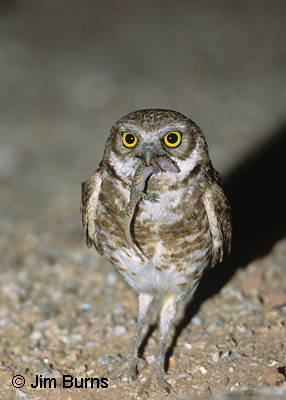
I'm down and dirty on the largest project run by Wild At Heart, an all-volunteer birds of prey rescue and rehab operation which Bob and "Sam" Fox established in 1990 and now operate out of Cave Creek. This hole I'm in is part of Wild At Heart's burrowing owl relocation program.
Burrowing owls, the most familiar and visible members of a largely nocturnal family of raptors shrouded by shadow and darkness, are medium sized (10 inches) diurnal owls most frequently observed on the ground outside their holes. Formerly associated on the western Great Plains with black-tailed prairie dog towns, burrowing owls have gone into sharp decline due to cattle grazing practices and, particularly in Arizona, the blading of agricultural lands.
Since the owls are protected under the Migratory Bird Treaty Act, conscientious developers and those unwilling to risk large fines call Wild At Heart before their bulldozers rumble in. Bob Fox removes up to 250 burrowing owls/year, houses them for 60 days until their instinct to fly back to the old territory is gone, then "replants" them under the auspices of U.S. Fish and Wildlife and Arizona Game and Fish in artificial burrows he has spent 16 years perfecting.
Backhoes break the ground, then you and I prepare the holes and lay out the elaborate series of plastic buckets, hoses, and pipes which approximates what a self-respecting burrowing owl would seek in its real world. For a look at the finished product, relocated owls and their new artificial homes, take a field trip to the Gilbert Riparian Area behind the library on the southeast corner of Guadalupe and Greenfield Roads in Gilbert.
For an appreciation of the thought and sweat that goes into each relocation, email Steve Thomas at steve.thomas@fastq.com or call him at 480-837-6323 and volunteer for one of Wild At Heart's half or full day projects. Their website is wildatheartraptors.org/.
If you and shovels don't mix, perhaps you'd like to host some new tenants on your property. The most pressing project need is for release sites. Saguaro desert areas don't work. Burrowing owls are a grassland species which eat insects and lizards, and they need open sites which look like farm fields. Ideal release sites are those with no large trees within 500 feet. Large trees hide great horned owls and Cooper's hawks. Great horned owls and Cooper's hawks eat burrowing owls.
Your grandchildren would probably enjoy seeing the same birds you're enjoying now. Burrowing Owls need you. Wild At Heart needs you.